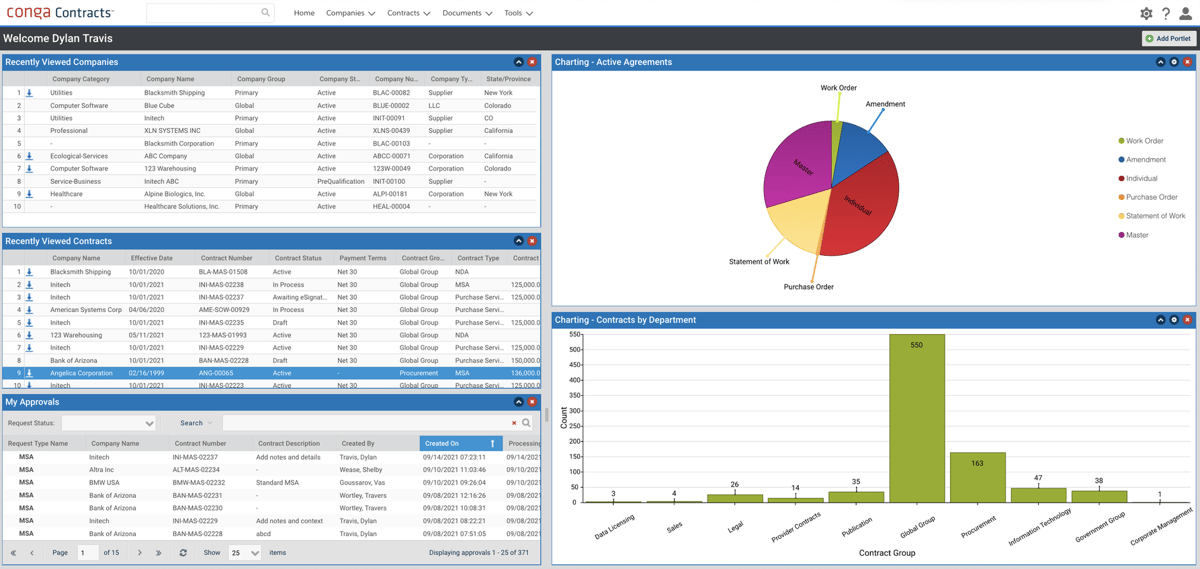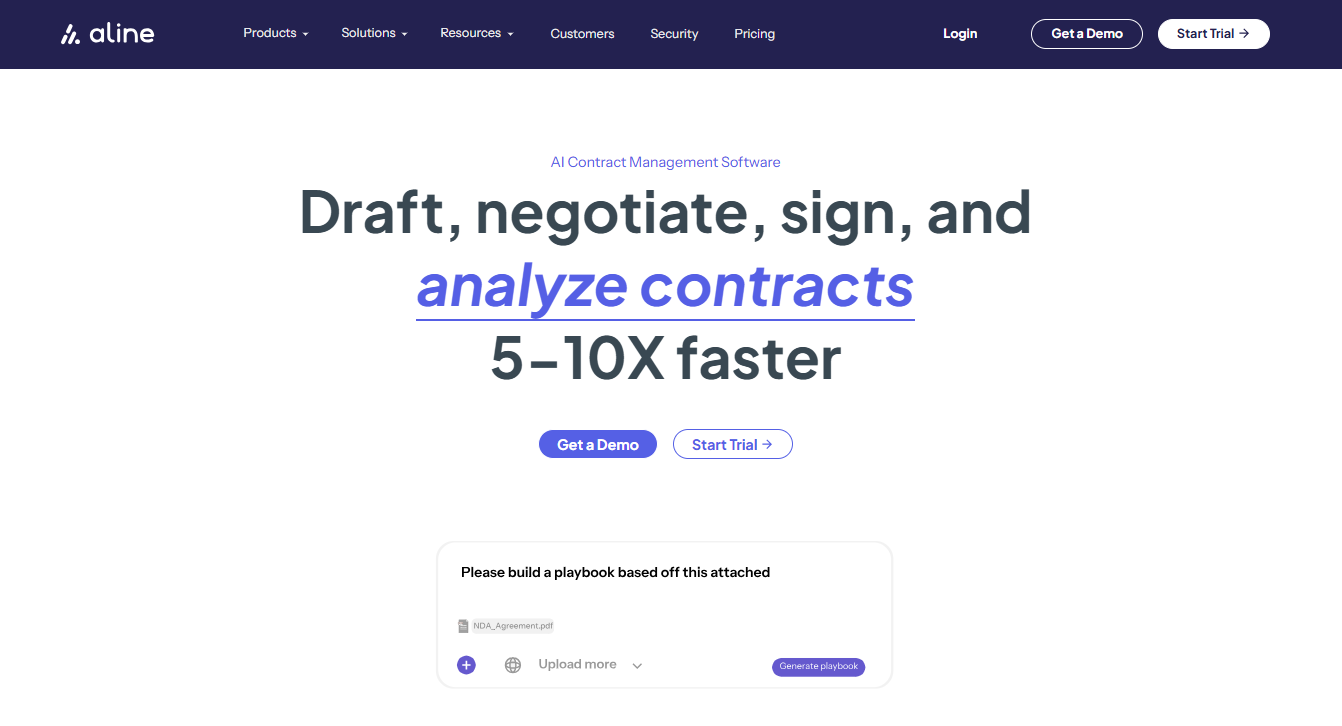When people talk about contract management, Conga CLM and DocuSign CLM usually top the list. Both are big names trusted by thousands of companies to handle contracts efficiently and keep deals moving.
They share the same goal, but they take different paths to get there. Conga is known for its strong Salesforce integration and automation tools, while DocuSign CLM builds on its world-famous e-signature software to manage contracts from draft to completion.
If you’re comparing options, understanding what each platform does best can help you decide which one fits your business goals. Below, we’ll look at how they work, what makes them popular, and where they differ.
Conga CLM is a contract lifecycle management platform that helps teams handle contracts from start to finish, creating, reviewing, approving, and renewing them in one place. It’s part of a bigger lineup of Conga products that focus on automating documents, revenue, and business processes.

What most people like about Conga CLM is how well it connects with Salesforce. If your team already lives inside that CRM, Conga makes it easy to pull in deal data, use approved templates, and send contracts for review or signature without leaving the system.
It’s also known for helping large companies cut down on repetitive contract work and stay compliant with company policies.
In short, Conga CLM is popular because it gives growing teams a structured way to manage complex contract workflows while keeping everything connected.
Most people know DocuSign for its e-signature software, which makes it easy to sign documents securely online. It’s one of the most trusted tools for handling legally binding agreements and has become a go-to choice for businesses of all sizes.

DocuSign CLM builds on that foundation by adding full contract lifecycle management capabilities.
Beyond digital signatures, it helps teams create, route, approve, and store contracts in a single tool. You can generate templates, set up contract approval workflows, and automate reminders so nothing slips through the cracks.
And because it connects directly with popular platforms like Salesforce, Microsoft 365, and Google Workspace, teams can manage contracts without breaking their workflow.
Aline is an AI-powered contract lifecycle management software that brings every part of the contracting process together in a single platform. It helps businesses draft, review, sign, and manage agreements without handling multiple tools like Word or DocuSign.
At its core, Aline combines automation, collaboration, and compliance features with powerful AI tools to make contract work faster and more reliable.
With Aline Associate, your built-in AI legal agent, you can draft, redline, or analyze complex contracts in minutes, not hours.
Its no-code Template Builder makes it easy for teams to create dynamic templates, while AlineSign provides unlimited, secure electronic signatures that meet ESIGN and UETA standards.
Aline also keeps every contract organized through its AI Repository, where data and key terms are automatically captured for quick search and reporting. From automating approvals to generating reports, Aline’s workflows keep legal and business teams in sync across every stage.
In other words, Aline replaces scattered systems with one connected software.
Choosing between Conga CLM, DocuSign CLM, and Aline depends on what your business values most. Is it deep integrations, trusted e-signatures, all-in-one automation, or perhaps something else?
Each platform brings something different to the table, from how contracts are created to how customers get their documents signed and tracked. Here are several differences you should take note of:
In this comparison, Conga CLM stands out for its Salesforce-focused automation, making it suitable for businesses already rooted in that ecosystem.
It can manage complex approval chains and compliance-heavy workflows, which allows large teams to move deals forward while keeping everything organized.
DocuSign CLM, as a DocuSign-based tool, builds on the brand’s success in digital signatures. It helps teams that already rely on DocuSign for e-signing expand into full contract management.
Its main strength lies in providing a familiar experience for existing users who want to grow beyond basic signing.
Aline, on the other hand, delivers a more unified approach. It blends AI contract drafting, no-code templates, automated approvals, built-in e-signatures, and more into one smooth platform.
Compared to the other tools, Aline focuses on simplifying the overall experience. This helps businesses keep contracts moving quickly and consistently while improving collaboration across teams.
Each platform comes with tools that make contract work faster and more organized. Here’s what stands out for each one.
The right contract management tool really depends on how your organization works and what you expect from it.
Conga CLM might be the best fit if your company already runs on Salesforce or uses other Conga products. It’s good for larger organizations that deal with complex approval chains and large volumes of contracts.
If you’re managing multiple vendors or partners, Conga gives you the structure and visibility you need, though it takes some setup before everything clicks. Once it’s in place, it’s great for keeping deals and sales processes consistent.
DocuSign CLM works well for businesses that already use DocuSign for legally binding agreements and want to go beyond simple e-signing. It’s popular among companies that value security, compliance, and smooth integration with tools like Microsoft 365 or Google Workspace.
If your users want a familiar system that’s easy to verify and expand, this might be your best solution.
Aline is built for you if you want one integrated platform that handles everything — creating contracts, collecting signatures, tracking renewals, and analyzing results. It’s a strong choice for small businesses and growing teams that care about speed and simplicity.
With Aline, you don’t have to waste precious resources juggling separate tools. You get AI-driven contract automation, clear workflows, and a clean interface that keeps your whole organization in sync.
Pricing is the deciding factor for many businesses choosing a contract management tool. Here is some pricing information on these three tools:
Conga CLM follows a custom pricing model, but the pricing isn’t publicly listed. The cost depends on your organization’s size, user count, and the specific plan or modules you choose.
DocuSign CLM also uses a custom quote system. Pricing varies based on contract volume, integrations, and legal automation needs.
Businesses can choose from different DocuSign product tiers, starting with eSignature plans and expanding into full CLM capabilities through enterprise-level contracts.
Aline offers transparent pricing plans with flexible options for teams of any size, plus a free 21-day trial so you can explore the platform before committing.
Aline’s pricing focuses on giving you full access to all core features under one plan. To learn more, check out the pricing page.
If you’ve made it this far, you’ve probably seen how Conga CLM, DocuSign CLM, and Aline each bring something different to contract management.
So, what do you really need — the power of Salesforce automation, the familiarity of DocuSign, or a single platform that does it all?

Conga and DocuSign have both earned their place in the market, but they often come with extra setup, add-ons, or third-party tools to reach full functionality.
Aline gives you everything in one place (AI drafting, built-in signing, reporting, and workflows), which means you don't have to manage multiple systems. In other words, it's perfect for teams that want speed, simplicity, and control.
If you’re tired of switching between tools to get contracts drafted, signed, and stored, Aline brings it all under one roof. Ready to see how it fits into your process?
Start your free trial of Aline today and experience how contract automation should really feel.
No. Conga Sign and DocuSign are separate e-signature tools. Both allow users to send and sign documents securely, but DocuSign is a standalone platform, while Conga Sign is part of the broader Conga suite that integrates directly with Salesforce and other Conga applications.
Conga is one of DocuSign’s main competitors, especially in the contract lifecycle management category. Other tools like Aline and PandaDoc also compete in this space, offering different approaches to automation and document workflows.
Conga is used for automating business documents and managing every stage of a contract. It’s known for enabling organizations to handle large contract volumes while maintaining compliance and accuracy.
In Salesforce, Conga acts as a native add-on that lets users generate contracts, proposals, and quotes directly from CRM data. This ability helps reduce manual entry and keeps every log and document linked to the right person, date, and transaction record.
Contract lifecycle management software is essential because it simplifies complex legal and sales processes, improves visibility, and reduces risk. It helps teams stay organized, track key dates, and manage every agreement efficiently. Additionally, it gives companies a more personal and reliable way to handle approvals and renewals at scale.

